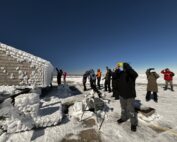The Mount Washington Club
By Peter Crane | October 1, 2023
The Observatory recently received a thoughtful gift from the family of the late James E. Welsh Sr. of Limerick, Maine. The donation was of a corkscrew which had an attached medallion from the “Mt. Washington Club”. What, the family wondered, was this Club, and what was its relationship to the northeast’s highest peak?
The item’s medallion also featured an image of the Summit House on Mount Washington, which was built in 1915, and which pointed the way to the significance of the “Club,” and to its founder, Henry Teague.

This corkscrew with an attached medallion from the “Mt. Washington Club” was recently donated to the Observatory.
Henry Teague was a larger than life entrepreneur whose story is intertwined with that of Mount Washington. In 1931, the Boston & Maine Railroad, owner of the Cog Railway, wanted to divest itself of the Cog, which did not fit into its usual business practice of routine passenger and freight service. They persuaded Teague to become manager and eventually owner of the Cog, and even made a loan to him for railway operations to sweeten the deal. Teague picked up the reins in April of that year, with a full transfer coming in 1939. Unlike the Boston & Maine, which ran the Cog like a railroad, Teague sensed that it was a different entity altogether, and instead ran the Cog as a tourist attraction. His approach, and his promotional efforts, proved successful throughout his involvement in the legendary Mount Washington railroad.
Along with the Cog came the Summit House – quite a package deal! That hotel, of course, served overnight visitors, some of whom had arrived via the Cog, others by hiking or by traveling up the Mount Washington Summit Road. Teague, who had experience as a hotelier, was happy to have overnight guests, no matter how they arrived at the peak. However, he had some hesitation about the many day visitors who were not Cog patrons who flocked to the summit, and then took advantage of the shelter of the Summit House and who used the hotel’s bathrooms. They enjoyed those amenities and paid not a penny. Though some of those transients doubtless purchased souvenirs or food at the hotel, Teague was dismayed that he was providing services for no compensation.
And so Teague transformed the Summit House into the “Mount Washington Club.” Cog Railway patrons automatically became members of the Club, and were welcome to free entry into the summit building. However, for those who ascended via the Road or up a hiking trail, a membership fee of fifty cents was charged to allow admission into the building. Members were given a membership card, which allowed them entry for the entire calendar year – such a bargain! – though doubtless Teague knew that most visitors would only visit the mountain once in a year. The Club had its official opening on July 2, 1932, with honored guests including New Hampshire Governor John Winant.

Mount Washington Club, White Mountains, N.H.
The Mount Washington Club was not just a new name for an existing building, but was a formally established legal entity. For whatever financial, tax, labor, liability, operational, or other reasons, Teague arranged to have the hotel and its restaurant, and other Cog property on the summit, leased to the Club. Teague, Dartmouth Class of 1900, had Myron Witham, a former Dartmouth College football star, Class of 1904, designated as President of the Club. Witham had a career as a coach and also as a teacher of engineering and mathematics. One can’t help but suspect that Mr. Witham was a figurehead, with Teague continuing to be in charge of all Cog and hotel operations on the mountain. (Officially, Teague was Treasurer of the Club, and John Carleton of Manchester, Dartmouth Class of 1922, and one of the first skiers to descend the Headwall of Tuckerman Ravine, served as Clerk. At this time Teague was President and Treasurer of the Cog Railway, Hanover hotelier Arthur Fairfield, Dartmouth Class of 1900 was a Director, and John Carleton was a Director and Clerk.)

Inside the Mount Washington Club. The caption on the reverse of the card reads, “At the top of
Mount Washington is the Mount Washington Club, a club in the clouds. Here is a modern hotel
at the very top of New England. All the passengers of the Mount Washington Cog Railway are day members of the Mount Washington Club.”
Henry Teague was involved in another important activity on the mountain at this time: he built the Observatory! The Mount Washington Observatory, founded, in 1932, was housed in two different structures in its earliest years, the Stage Office of the Mount Washington Summit Road Company, and Camden Cottage, a similar small building associated with the Summit House and the Cog. As the fledgling Observatory’s operation evolved, the Stage Office became its winter home, and the Camden Cottage, its summer home. Since both of those buildings had other, albeit seasonal uses, neither was wholly suitable for use as a permanent summit weather station. Teague, doubtless after significant communication with Joe Dodge, had a purpose-built structure erected for rent to the Observatory in 1937. Initial terms in the twenty-year lease called for a rent of $500 per year, and also prohibited the sale of food, supplies, postcards, souvenirs and the like at the Observatory whenever the Mount Washington Club was open for business. In later years, Teague effectively lowered the rent to $250 per year, a kindness much appreciated by the Observatory. (This sturdy wooden building remained in use as the summit weather station until 1980, when the Observatory moved into the then-new Sherman Adams Building.)
The Mount Washington Club continued its operations on the summit until Teague’s death in October 1951. As Cog Railway historian Donald Bray noted of Henry Teague, “He was a dynamo of enthusiasm who motivated his people and won their trust.” Teague also kept his alma mater, Dartmouth College, in high esteem, and was doubtless thankful for the loan from the College that helped the Cog make essential repairs after the hurricane of 1938. By the terms of Teague’s will, all his Mount Washington holdings, including Marshfield Base Station, the Cog Railway, the Summit House, and associated land were bequeathed to Dartmouth.

Henry N. Teague, (1875-1951). One former employee of Teague wrote, “He was quick of temper but as fair a man as I ever knew.” His business acumen made the Cog Railway a stunning mid-20th century success.
Arthur Teague, a very, very distant relative of Henry Teague who had worked at the Cog before World War II and who been hired as Vice-President and General Manager of the Cog in 1945, was hired as General Manager of the Cog by Dartmouth. While Arthur Teague was selected as president of the Mount Washington Club in November 1951, it seems that the Club concept would soon be abandoned, and under Dartmouth ownership the original name of the Summit House was again employed. As Observatory veteran (a member of the founding crew in the winter of 1932-1933) and Dartmouth College Forester Robert Monahan noted at a June, 1952 meeting of the White Mountains Region Association, “The ‘Mount Washington Club’ is once again the ‘Summit House,’ as we knew it in the years of such hosts as Mrs. Dodge and Allie Wright.” (Harriet Dodge had managed an earlier Summit House from 1877 to 1883; Alvah Wright worked at the Summit House for three stints between 1888 and 1931.)
In 1962, Arthur Teague purchased the Cog Railway from Dartmouth College, and entered into a lease arrangement with Dartmouth for use of the Summit House. In 1964 the State of New Hampshire purchased about 59 acres at the summit which became Mount Washington State Park. The purchase included the Summit House, which was leased, for a time, to the Cog Railway. It provided overnight lodging through the season of 1966; deterioration of the building and its infrastructure caused that year to be the last year of overnight accommodation. In 1980, the Summit House – the third building to be known by that name, and the only one also known as the Mount Washington Club – was razed, with the new Sherman Adams Building succeeding it as the Visitor Center for Mount Washington State Park. A further 8 acres was added to the Park when the State purchased Dartmouth’ s remaining land on the summit in 2008.
While reflecting on the Mount Washington Club, one might think that it was not especially hospitable of Henry Teague to charge summit visitors a fee to escape the harsh elements atop the mountain by entering his humble building. However, Teague did have bills to pay, and visitors who were benefiting from the amenities of his summit hotel, whom he not unreasonably thought should contribute to the provision of such services. Indeed, his has not been the only mind to consider charging to enter a summit structure. When Mount Washington stakeholders were discussing the operation of the state’s Sherman Adams Building, opened in 1980, the possibility of charging to enter the building, or part of it, was seriously discussed. One potential sticking point was access to the bathrooms, and the concern that if people could not readily access those facilities, an unfortunate and unsanitary result could occur. Today’s visitors will note that the Sherman Adams Building has entry doors, PLUS a significant doorway just beyond the restrooms and information desk, an architectural feature that would allow a barrier and admission station.
Could such a concept arise again? As recently as 2020, the possibility of charging an admission fee to the building was a matter of earnest discussion for the Mount Washington Commission, the state board that advises on operation of Mount Washington State Park and serves as a forum for the varied interests associated with the mountain. Recognizing the significant costs of State Park operations, including the provision of water and the treatment of sewage, the Commission seemed well disposed to the possibility of an entrance fee, but also acknowledged that persuading the powers that be in Concord of the desirability of a fee would be a challenge. Focus was shifted to updating the Park’s Master Plan, but with that document now accepted by the Commission and by Governor and Council, discussion of a fee could be revisited.
While a fee to enter the Summit Building could return it seems unlikely that the “Mount Washington Club” will be resurrected. The Club remains as an obscure but noteworthy part of the mountain’s storied history.
Special thanks to Tim Lewis of Northern Vermont University, whose extensive research on the Mount Washington Cog Railway has brought to light helpful information about the Mount Washington Club. The author benefited from communications with Professor Lewis and with historian Rob Bermudes. Mr. Bermudes has observed that, given the details of the Cog arrangement with the Boston & Maine, and the nature of the loan (mortgage) from Dartmouth – which may have been more to settle with the B & M than to repair hurricane damage – perhaps Henry Teague never owned the Cog outright – a worthy subject for further consideration.
2024 Total Solar Eclipse: Two Perspectives
2024 Total Solar Eclipse: Two Perspectives By Karl Philippoff and Francis Tarasiewicz Mount Washington, New Hampshire (Francis) I got into meteorology in part, because of how the weather can, even if briefly, bring us
From Mount Washington to Antarctica
From Mount Washington to Antarctica By Charlotte Markey What do Antarctica and the summit of Mount Washington have in common besides weather? Having worked as support staff for both locations, I can tell you
Mount Washington Observatory to Host 90th Anniversary Big Wind Day Celebration
Mount Washington Observatory to Host 90th Anniversary Big Wind Day Celebration North Conway, NH – March 23, 2024 – In commemoration of the 90th anniversary of the highest wind speed ever recorded at a



